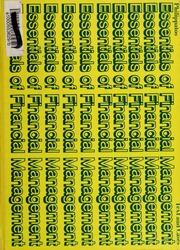conduct the following analysis on the stock Mcdonalds (MCD Go to the balance sheet of the firm and look up the long-term debt and the short term debt. This information can be widely found from the Yahoo finance web page along with many other sources. Go to the income statement for the firm and obtain the interest expense (sometimes called total interest). Use the total long-term debt and the interest expense to calculate the percent expected returm on the debt of the firm. 1. 2. 3. As in the prior project, you must use the (CAPM Capital Asset Pricing Model) to 4. Using the data from the balance sheet, calculate the equity weight for the firm and the 5. Using the expected stock (equity) return from 3 and debt return from 2, calculate the calculate the expected return from the equity (stock) of the firm. debt weight. It is okay to assume that the firm has no preferred stock. weighted cost of capital from the weighted cost of capital equation using the book value of debt. Repeat the above calculations assuming that the book value of debt is the same as the market value of debt. Use the market capitalization of the firm as the market value of equity and repeat the calculations for weighted average cost of capital. 6. McDonalds (MCD) Long term debt: Total debt: Interest expense: Expected rate of return on debt Stock beta Expected return on equity Equity weight (book value Debt weight (book value) Weighted average cost of capital Expected return on equity Equity weight (market value): Debt weight (market value): Weighted average cost of capital (market value After filling out the above table, answer the following question about weighted average cost of capital (WACC). Suppose you are a manager faced with various profects at the company you calculated the WACC for. How would you use this number to evaluation projects for the firm? What would be your decision criterion for accepting a project or rejecting it? Explain why you might use market value weighted average cost of capital as opposed to boolk value. Weighted average cost of capital equation: WACC ReRd -(-T conduct the following analysis on the stock Mcdonalds (MCD Go to the balance sheet of the firm and look up the long-term debt and the short term debt. This information can be widely found from the Yahoo finance web page along with many other sources. Go to the income statement for the firm and obtain the interest expense (sometimes called total interest). Use the total long-term debt and the interest expense to calculate the percent expected returm on the debt of the firm. 1. 2. 3. As in the prior project, you must use the (CAPM Capital Asset Pricing Model) to 4. Using the data from the balance sheet, calculate the equity weight for the firm and the 5. Using the expected stock (equity) return from 3 and debt return from 2, calculate the calculate the expected return from the equity (stock) of the firm. debt weight. It is okay to assume that the firm has no preferred stock. weighted cost of capital from the weighted cost of capital equation using the book value of debt. Repeat the above calculations assuming that the book value of debt is the same as the market value of debt. Use the market capitalization of the firm as the market value of equity and repeat the calculations for weighted average cost of capital. 6. McDonalds (MCD) Long term debt: Total debt: Interest expense: Expected rate of return on debt Stock beta Expected return on equity Equity weight (book value Debt weight (book value) Weighted average cost of capital Expected return on equity Equity weight (market value): Debt weight (market value): Weighted average cost of capital (market value After filling out the above table, answer the following question about weighted average cost of capital (WACC). Suppose you are a manager faced with various profects at the company you calculated the WACC for. How would you use this number to evaluation projects for the firm? What would be your decision criterion for accepting a project or rejecting it? Explain why you might use market value weighted average cost of capital as opposed to boolk value. Weighted average cost of capital equation: WACC ReRd -(-T







